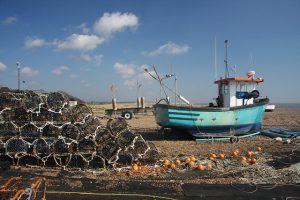Fuel consumption of global fishing fleets
By Gabi Goodrich, RJD Intern
Everyone is well aware of the problem of overfishing. Fishing fleets go out and fish until they meet their quota. While over fishing is a major problem for the oceans health, another, less talked about side of the issue is the fuel consumption of those fishing fleets. As the “fight to fish” grows, fleets have become bigger and more powerful fleets. With the public concern for green products, the use of high emission energy sources has been put into the spotlight. In an article titled “Fuel Consumption of Global Fishing Fleets: Current Understanding and Knowledge Gaps,” Robert W R Parker and Peter H Tyedmers studied more than 1,600 records of fuel use by fleets worldwide using all types of fishing methods.
It is apparent that some are bigger offenders than others. Some of the most popular foods hold the top ten spots, with shrimp and lobster coming in at number one for worst offenders. It is interesting to see that the global difference between fishing practices. While globally, shrimp and lobster hold an average of 2932 liters per ton, the fuel use intensity (FUI) is 783 liters of fuel to catch one ton of Maine Lobsters from traps, while the Norway Lobster takes 17,000 liters of fuel per ton in the North Sea (Parker 2014). These variations, however, can be attributed to different fishing styles, gear, and availability and magnitude of what they are trying to catch. Those to have to travel farther and longer distances to find the desired catch use more fuel than those who have to travel shorter distances and have greater potential to land the desired catch. Catches like the Peruvian Anchovy, Atlantic Mackerel, and Australian Sardine are some of the most efficient fisheries and are some of the largest fisheries globally, by volume of landings. The use of purse seine gear or other surrounding nets average an FUI of 71 liters per ton while trawling for small pelagic fish has an FUI of 169 liters per ton (Parker 2014).
So what does this all mean? According to the FUI records, the median value is 239 liters per ton. That’s roughly an average of two kilograms of carbon dioxide produced per kilogram of seafood caught and landed. To put that into perspective, beef has an average of just over 10 kilograms of CO2 per kilogram produced, pork has just less than 6 kilograms of CO2 per kilogram. While compared to other sources of food, the production and fishing of seafood is relatively low. The study does have some serious implications. The most efficient sources of fishing (small pelagic fisheries) are often overlooked as a viable food source in developing countries and are instead used for aquaculture and livestock. Furthermore, with fuel prices on the rise and carbon emission regulations and laws growing stricter, the profitability of the fishing industry will be compromised. Parker and Thyedmers say the most effective way to improve the energy performance of fisheries is to rebuild stocks and manage capacity effectively.


